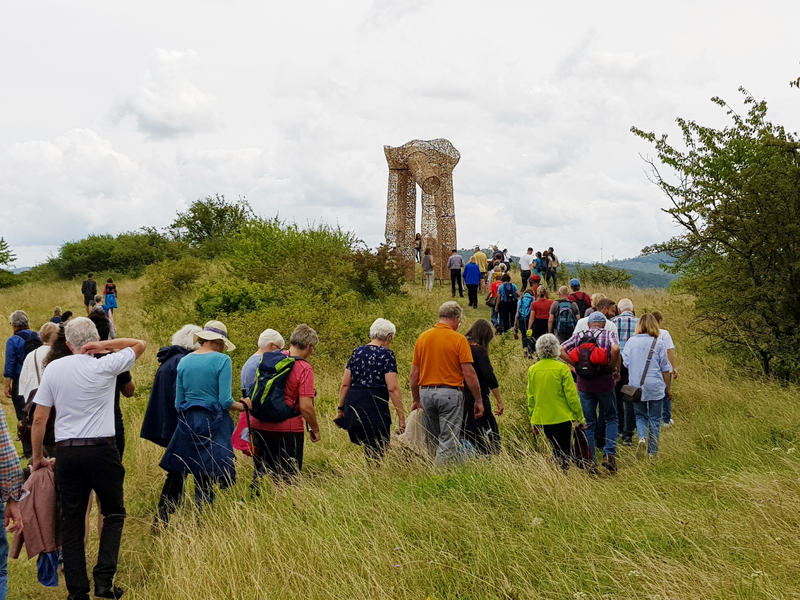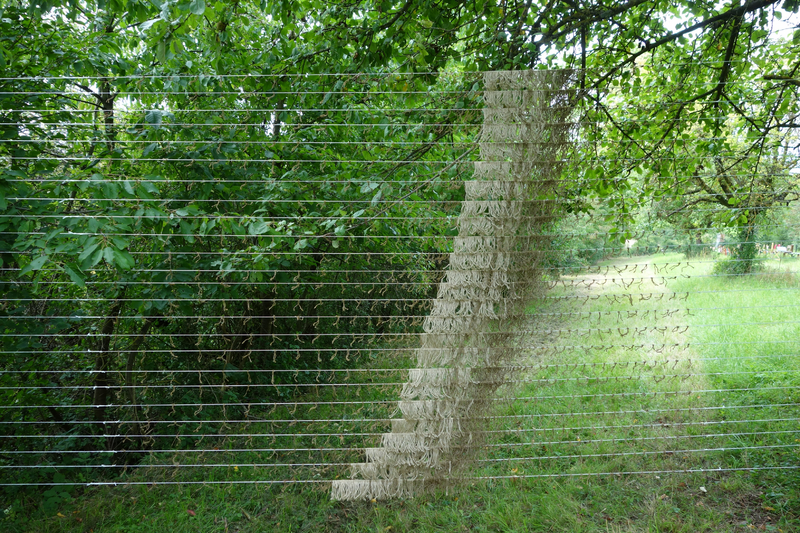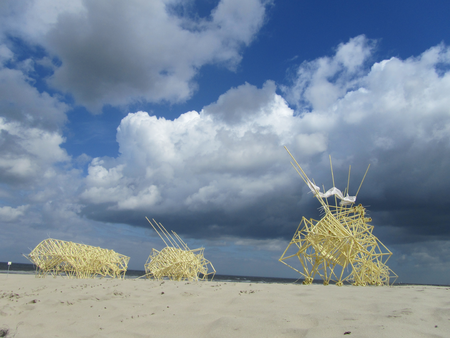Moved by the Wind
At our Online Club in November, we had two special guests: artist and curator Reita Reinl from Bewegter Wind Festival in Germany and scientist-turned-artist Theo Jansen, father of the Strandbeesten (beach animals). A truly moving get-together!

Bewegter Wind Festival
“It is often said that the wind is a metaphor for the soul”, this is how Reita Reinl starts her talk on the organisation Bewegter Wind. It is an outdoor art festival that has brought together 601 artists from 37 countries in 710 exhibits. In recent years the festival venues were concentrated in Northern Hesse and around Kassel in Germany.
The works exhibited throughout the years can take on various forms and shapes such as the installation Sanfika (2005) by Surinam artist Marcel Pinas, in which hundreds of spoons are dangling in the air and make a noise reminiscent of wind chimes. Or Chinese artist Wang Haiyuan, who with his work Media (2012) spread rice papers of biodegradable material with smiley faces printed on them across fields, and thus showed how the wind spread these pieces of paper around differently each day
Every edition there is a new theme that artists can correspond to such as “changing horizons” (2016), “clouds” (2018), and the most recent edition in 2023 had the theme “beyond …darüber hinaus”. For example, for the “changing horizons” edition Estonian artists Katri Pekri and Alide Zvorovski made tiny porcelain chairs that they spread out on a field. The work only took up two square metres, but the photographs of the work Auditorium (2016) play with illusion and make the landscape in which the chairs are standing seem vast. Another example, for the edition of 2018 German artist Judith Mann created Cloud-Meat/Nebel-Aue (2018) in which a constant cloud of mist hangs in a field, creating a mysterious atmosphere that would also change depending on the light fall during the day.
During each edition of the festival three works are selected to win an award with the prize money comprising €7.000. The last edition the first prize went to the work Vor dem Wind, Atlantik, Passatwindzone (2023) by German artist Anne Heilmann. Her artwork seems simple a grid, with little strings tied to it, but in connection with the poetical work that visitors could listen to it becomes obvious that these slight changes in formation of the strings are carried out by winds coming all the way from the Atlantic Ocean travelling through Northern Hesse.
The next festival is coming up in the summer of 2025, although this still seems faraway the organisation of Bewegter Wind is already in search of artists with new inventive ideas for an artwork, whether it be a land artwork or a performance. The possibilities to let your imagination run with the wind are endless.
Theo Jansen’s Beach Animals
https://www.strandbeest.com/
There is a fresh breeze, the seagulls screech above your head, and the waves calmly wash ashore. During your stroll at the beach, you suddenly see enormous creatures crawling towards you rustling up the sand. This fantastical image has become a reality through the artworks by the Dutch artist Theo Jansen (1948). During the online gathering Moved by the Wind Jansen tells all about his intricately engineered Strandbeesten that he makes from yellow electricity pipes that walk on the wind at the beach of Scheveningen near The Hague.

The host of the online gathering curator Anne Berk remarks how magnificent his constructions are. He replies that in his art he isn’t in search of beauty but wants his artworks to function. If they can’t move by themselves the experiment to him has failed. His background sheds light on his stance. He studied physics at the Technical University of Delft for seven years, after which he decided that he preferred to draw and paint.
He built up a lucrative art practice while he stayed on as student assistant at the university. However, he tells us how the year 1980 was a crucial turning point in his art practice when he decided to build a UFO, which in essence was an ellipse constructed of electrical tubes and covered in black agricultural plastic, which is filled with helium gas. He released it above the city Delft. In a short television fragment, we see how residents as well as police are astonished by what they have seen and can’t believe their eyes. The UFO vanishes in the clouds and is never sighted again. After four days the commotion around the UFO is put to rest when the broadcasting corporation VPRO uncovers that it was actually an artwork by Jansen.

From that moment onward Jansen can’t paint anymore. Instead, he wants to grab people’s imagination and starts using his background in engineering in his art practice. For example, he builds a painting machine, which can be seen as a combination of a camera obscura and a printer. The machine can detect objects through a light sensor and make a painted copy of it on the wall.
During this period, he also becomes a columnist for the science section of the national newspaper De Volkskrant. In one of his articles from 1990 he launches his idea for Strandbeesten (Beach Animals), which would help to elevate the Dutch coast by adding sand to the dunes. This of course corresponds to a problem that is becoming more relevant each day: the rising sea levels and the fragile disposition of the Netherlands (which means low countries). For Jansen this is an element that he is aware of, although the aim for his work has developed from shifting sand to making it possible for his creatures to independently walk in herds when humanity has ceased to exist.
For years he has been creating his intricately engineered Strandbeesten made from electricity pipes that walk on the wind. These huge constructions of dinosauric proportions allude to caterpillars, beetles, and other small insects. There are cross-walkers that move sideways, like a crab on the beach, but there are also wind-followers that are pulled ahead by big white sails and move along the coastline. Some also contain pressed air in soda bottles to propel them forward.

Jansen started developing his kinetic structures by using evolutionary computation techniques. Inspired by the book The Blind Watchmaker by Richard Dawkins he now only experiments with his creatures in real life on the beach of Scheveningen. This is in line with Dawkin’s theory in which he contrasts human design to natural evolution and compares it to a blind watchmaker who ‘creates’ a watch without any insight or planning. For Jansen his visits to the beach are trial and error. He tells how he failed to get his Strandbeesten to move independently the whole summer. Only in September with the perfect weather conditions and wind circumstances was he able to make his most recently created Strandbeest walk.
However, you don’t have to be in Scheveningen to experience Strandbeesten. During the Corona-pandemic Jansen was able to infect many people worldwide through his Youtube-channel with the virus to make a Strandbeest themselves. The videos not only show beautiful images, but also how the Strandbeesten are constructed and how to avoid them being buried in a sandstorm. According to Jansen this is how Strandbeesten procreate. In contrast to the Coronavirus in which screens are used between humans to keep the virus at bay, here the screen is crucial to inspire others to make their own Strandbeest.

His Strandbeesten are now exhibited worldwide, for example in the Chiba Prefectural Museum of Art in Japan. It was even featured in an episode of the comedy-series “The Simpsons” in 2016. Let’s hope that spotting a Strandbeest won’t depend on a mere chance sighting, but that they will soon parade in great herds along the beach all over the world.









